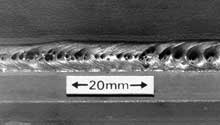Understanding Porosity in Welding: Checking Out Causes, Impacts, and Avoidance Strategies
As specialists in the welding industry are well mindful, recognizing the reasons, results, and avoidance methods associated to porosity is important for accomplishing robust and reputable welds. By delving into the origin creates of porosity, analyzing its harmful results on weld high quality, and discovering efficient avoidance techniques, welders can improve their understanding and abilities to generate top quality welds constantly.
Typical Sources Of Porosity
Contamination, in the type of dirt, oil, or rust on the welding surface, creates gas pockets when heated up, leading to porosity in the weld. Inappropriate securing occurs when the protecting gas, generally utilized in procedures like MIG and TIG welding, is unable to completely shield the molten weld swimming pool from reacting with the bordering air, resulting in gas entrapment and succeeding porosity. Additionally, insufficient gas insurance coverage, frequently due to inaccurate circulation prices or nozzle positioning, can leave components of the weld vulnerable, enabling porosity to create.
Effects on Weld Top Quality
The presence of porosity in a weld can considerably endanger the total top quality and integrity of the welded joint. Porosity within a weld develops spaces or tooth cavities that damage the framework, making it a lot more vulnerable to splitting, rust, and mechanical failure.
Moreover, porosity can impede the performance of non-destructive screening (NDT) strategies, making it challenging to identify various other defects or discontinuities within the weld. This can bring about considerable safety and security worries, particularly in essential applications where the structural honesty of the welded parts is vital.

Avoidance Techniques Summary
Given the damaging effect of porosity on weld top quality, efficient prevention strategies are vital to preserving the architectural stability of welded joints. Among the main prevention methods is complete cleansing of the base products before welding. Impurities such as oil, grease, corrosion, and dampness can add to porosity, so making certain a tidy work surface area is vital. Proper storage of welding consumables in completely dry conditions is also essential to avoid moisture absorption, which can bring about gas entrapment throughout welding. Furthermore, selecting the proper welding criteria, such as voltage, existing, and take a trip speed, can assist minimize the risk of porosity development. Ensuring adequate protecting gas circulation and protection is an additional vital prevention method, as not enough gas coverage can lead to climatic contamination and porosity. Finally, appropriate welder training and qualification are vital for applying preventive steps properly and regularly. By integrating these avoidance strategies right into welding techniques, the incident of porosity can be significantly decreased, causing more powerful and extra trustworthy welded joints.
Relevance of Appropriate Protecting
Proper shielding in welding plays an essential role in stopping atmospheric contamination and making certain the integrity of bonded joints. Protecting click here for more info gases, such as argon, helium, or a combination of both, are commonly utilized to protect the weld swimming pool from responding with aspects in the air like oxygen and nitrogen. When these reactive elements enter into call with the warm weld swimming pool, they can trigger porosity, resulting in weak welds with decreased mechanical properties.

Inadequate securing can lead to numerous problems like porosity, spatter, and oxidation, endangering the architectural integrity of the bonded joint. As a result, sticking to correct protecting techniques is important to generate top quality welds with marginal defects and ensure the long life and reliability of the welded elements (What is Porosity).
Monitoring and Control Techniques
How can welders effectively monitor and manage the welding procedure to make sure ideal results and avoid problems like porosity? By continuously monitoring these variables, welders can identify deviations from the ideal problems and make instant modifications to protect against porosity development.

In addition, carrying out appropriate training programs for welders is vital for keeping track of and controlling the welding procedure efficiently. What is Porosity. Enlightening welders on the value of preserving regular criteria, such as appropriate gas shielding and travel speed, can help avoid porosity problems. Regular assessments and qualifications can likewise ensure that welders are competent in try this web-site surveillance and managing welding processes
Additionally, the usage of automated welding systems can enhance surveillance and control abilities. These systems can specifically control welding specifications, reducing the chance of human error and making certain consistent weld top quality. By combining innovative tracking modern technologies, anonymous training programs, and automated systems, welders can properly keep track of and regulate the welding process to reduce porosity defects and attain premium welds.
Final Thought
